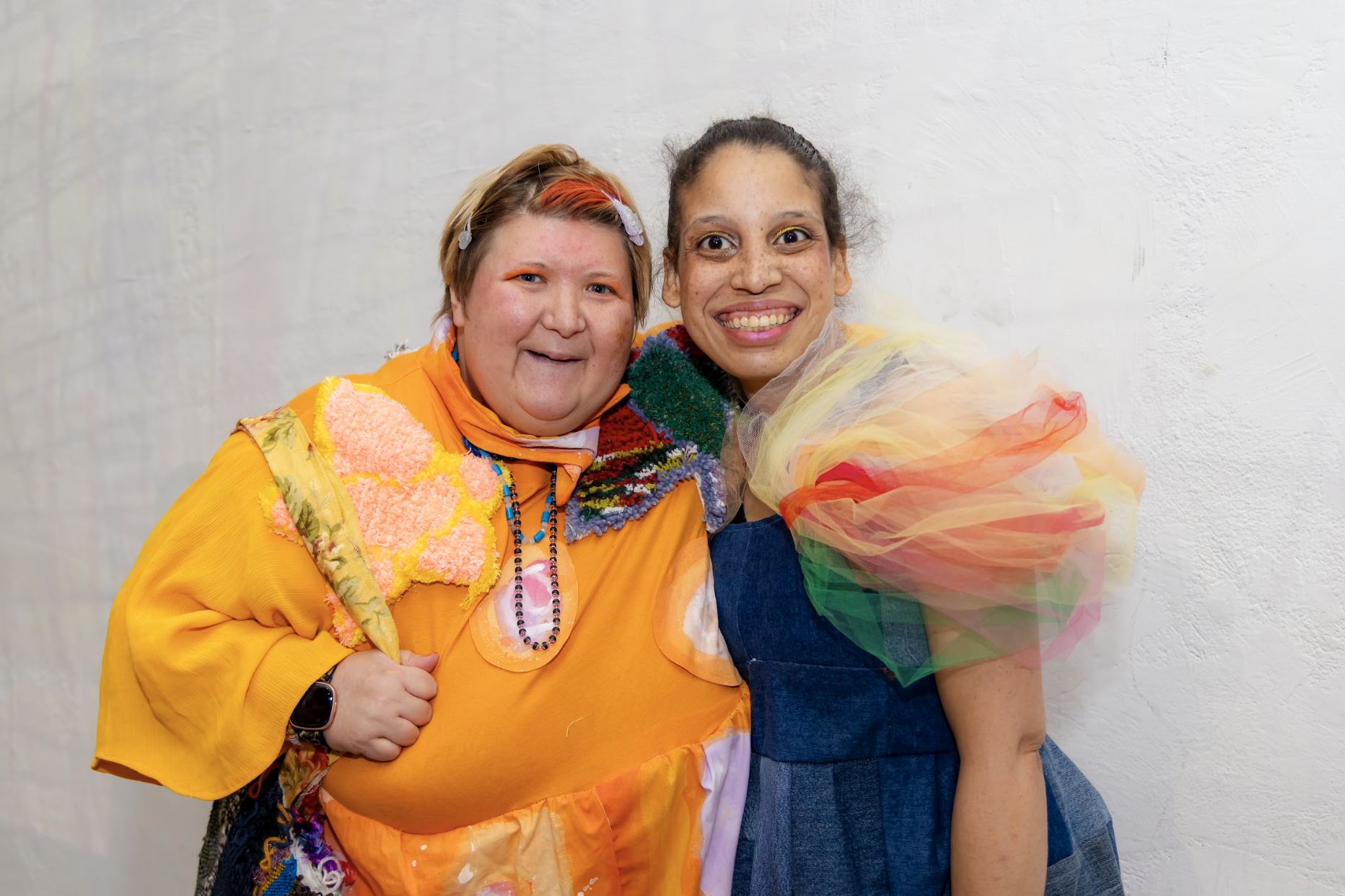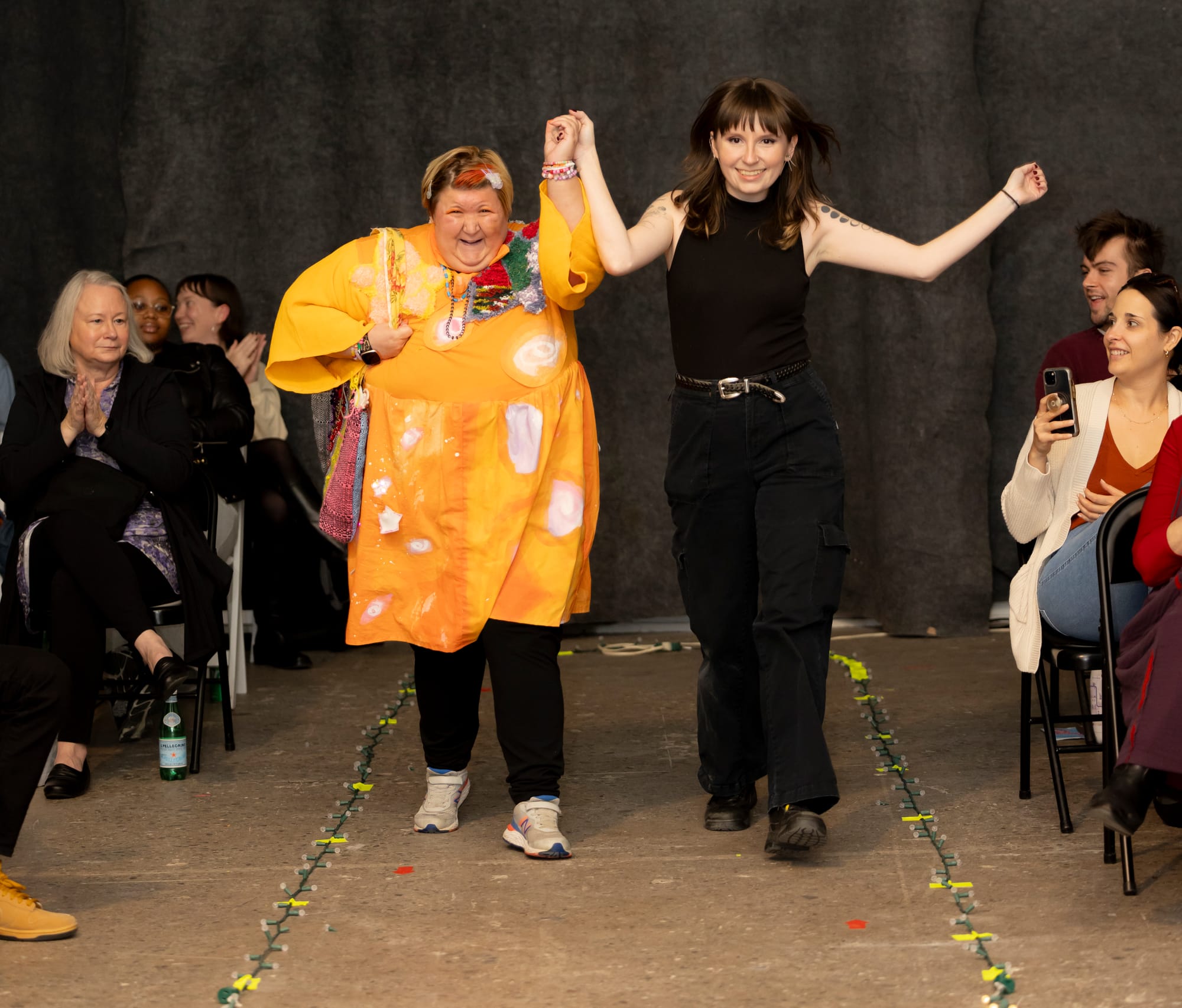The lights lower. A woman wearing a dress made from bright orange silk spins at the top of the runway; a few tufted stars in unexpected colorways decorate the bodice. The audience lining the runway oohs and aahs as LED lights sewn into the skirt begin to glow. Every detail of the dress is playful in a way that today’s top designers can only wish to achieve, the model a sunbeam embodied.
Artist Jenna Powers made and modeled that dress during last Saturday's “Disco Kitchen,” a fashion show fundraiser featuring the works of 30 designers with developmental disabilities. The event was hosted by the Center for Creative Works, an art studio focused on “developing creative workplace potential and cultural identity for people with intellectual disabilities,” as their website puts it. When Powers sashayed down the runway, I felt like I was watching a sunrise saturated with disabled joy.
Oftentimes abled folks cannot conceive of disabled joy without pity. They get lost in their own imaginations, stumbled by the disorders and wrongness they believe our bodies are burdened by. But at Saturday's show, celebration took center stage through flexibility of form and fashion.
“Are you ready to partyyyyy?!” the MC yelled at the start of the show. His co-presenter helped him find the microphone with his seeing eyes. I looked around the room — the audience was spread around The Icebox gallery, a high-ceilinged space with warehouse floors. The place was stocked with life solely because the Center for Creative Works chose to fill it and us up.
Textile was at the center of the line-up. There was intense focus on intricate patterns made by painting and weaving that molded into bold shapes unafraid to take up space. More than once I saw boiler suits covered in detailed paintings that focused mostly on color and abstract lines, stretched like fabric maps across the model’s bodies.
The audience could rely on the CCW staff members and organizers to help the artists get down the runway and express in poses how their pieces made them feel. There were spins, bows, waves to the audience, and plenty of finger guns. A CCW staff member held the hand of one designer wearing a hand painted frock, keeping her close while she floated down the runway. The model’s cheeks were painted with red hearts to match the streaks of red in her hair. The dress was loose and decorated with dulled shades drawn from the full spectrum of the rainbow.

Other pieces were sculptural — one designer, for example, wore a cardboard propeller on his back and walked a paper mache dragon on a leash, dragging it behind him like a tired dog. Still, others were more traditional in their modes of glory: Tulle, in deep red, butter yellow, seafoam green and lavender drift down the concrete floors in one of the final gowns. The colorful netting was attached to a denim patchwork mini dress, at the top of which were ballooning, tulle sleeves. She looked beautiful and she knew it.
Projected images that CCW artists had drawn and painted covered the entire wall in front of the runway. Once models reached the front, their bodies were placed in the world of Disabled art.
By the time Powers’ iconic glowing, orange dress blessed the runway, the audience, made up of mostly family members of the designers, were cheering as loudly as they could. Every garment and personality-ridden runway walk was more exciting than the last. Though the energy of the designers was part of the party, the quality and creativity of the garments stood out on their own terms. Other than a friend I brought along, the audience seemed small and close-knit, primarily family members of the designers. Where were the abled people not just willing, but wanting to see Disabled joy strutting down a runway?
At the end of the event, one of the artists took to the mic again, describing the “nonstop action and a lot of drama in the workroom” that preceded the one-off night. We are all living our Project Runway dreams. I felt confident that even the neurotypicals in attendance had been fed an opportunity to benefit from Disabled culture and art put on display — but it was also an afternoon for the rest of us to relax our bodies, move freely, yell loudly, and forget abled body politics. In the end, one of the designers put it aptly in saying “there’s people, there’s family, there’s the whole world. I’m getting a raise, amen.”
At Disco Kitchen, there’s the whole world.







